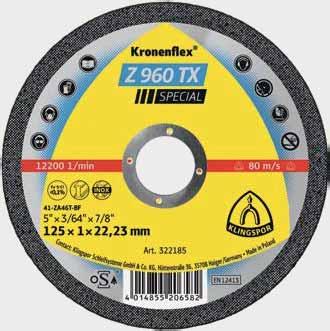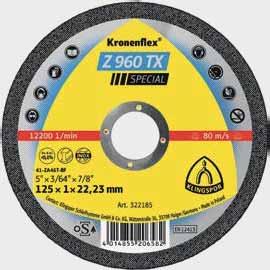
7 minute read
Kronenflex® cutting-off wheels and grinding discs
About the product
As the inventor of the high speed cutting-off wheel, it is only natural that we strive to continually develop and improve our Kronenflex® products.
Kronenflex® cutting-off wheels and grinding discs feature an optimal combination of bonding agent and grain type for high aggressiveness, outstanding service life and consistently high quality. They comply with the highest safety standards, including the oSa regulations and the European safety standard EN 12413.
As a result of continuous innovations and the development of special products for diverse requirements, our Kronenflex® products offer the optimal solution for all standard materials and applications.
Typical materials for these products
Steel
Stainless steel
Construction steel
NF metals
Cast materials
Stone
Plastics
Mineral materials
Cutting-off wheels
Pipes
Flat irons
Tins
Solid materials
Typical applications for these products
Bodywork
Maintenance and repair work
Locksmiths
Steelwork
Plant construction
Container construction
Upkeep
Metal works
Vehicle construction
Foundries
Shipyards
Kronenflex® cutting-off wheelsKronenflex® grinding discs
Kronenflex® cutting-off wheels and grinding discs
Application guides
1. EAN code (EAN 13)
2. Safety pictograms
3. Max. operating speed
4. Klingspor cat. number
5. Specification of design, grade and bond according to EN 12413
6. Dimensions in mm and inches
7. Applications (see colour coding system)
Performance classes
8. Information about the manufacturer
9. Operating restrictions
10. Safety standard (oSa / EN 12413)
11. Max. RPM
12. Safety pictograms
13. Product group / type
14. Klingspor brand Kronenflex®
Kronenflex® cutting-off wheels and grinding discs come in three performance classes with six colour codes for a quick overview of the most important material applications.

Products for universal application, offering a particularly attractive price-performance ratio.
Optimised products for different applications. Excellent service life and cutting performance.
High performance products for special applications. Highest service life and cutting performance in the respective material application area.
Kronenflex® cutting-off wheels and grinding discs
Application guides
1. Label and cover sheet
The label includes all of the important information on the product, manufacturer and information on the proper use of the grinding tool
2. Mixture
The grit: Today all grit types are only produced synthetically. Only grit produced synthetically can ensure continuously high wear and cutting disc quality.


Resins and fillers: Additional, important components for cutting and grinding discs are resins, (in liquid and dry form), and fillers. These components are key in determining the disc properties, such as stability, stock removal rate, sheer strength and can be adjusted to meet the needs of the specific application.
3. Metal ring
Provides information on the expiry date of the disc.
4. Glass fibre
Glass fibre is a reinforcing layer to ensure stability and increases the safety of the cutting-off wheel. The number and strength of the glass fibre layers is dependent upon the disc type and application.

The higher the potential lateral load on a cutting-off wheel (it is greater during free cutting than during stationary cutting), the more glass fibre that the cutting disc must contain, or the contained glass fibre must be more stable. Particularly thin material is used for thin cutting discs, (0.8 mm to 1.0 mm), to ensure that a large grit ratio is achieved between the layers. Grinding discs are constructed with at least 3 glass fibre layers.
Cutting-off wheels
Klingspor cutting-off wheel and grinding disc colour coding system
Pictograms on the product pages
Kronenflex® cutting-off wheels and grinding discs
Application guides
Safety and storage
The shelf life of cutting-off wheels and grinding discs is primarily determined by their moisture content. Cutting-off wheels and grinding discs that are subjected to increased humidity a er they were manufactured loose their original service life. Correct storage ensures a consistent long service life. Cutting-off wheels and grinding discs that are subjected to water or steam are a safety risk. The user is obligated to use the product correctly. Cutting-off wheels and grinding discs should not be used past the expiry date.
Working safely
By being careful and recognising risks contact with rotating abrasive discs abrasive disc breakage grinding dust and debris vibration noise
Please avoid the risks listed below when working with cutting-off wheels and grinding discs.
Through personal protective gear
Goggles, gloves, ear muffs and dust masks must be worn. When working on hard grinding applications additional protective gear is required, such as face protection, leather aprons and safety boots.
With protective machine guards
Machine guards are supplied with the grinding machine and may not be changed or removed. When using cup grinding wheels the outer surface must be completely enclosed.
In addition, cup grinding wheels may only be used in combination with an adjustable wheel guard, to balance the wear on the disc and to keep the exposure of the disc at a minimum.

Through visual inspection and performance of checks prior to mounting
Ensure the disc RPM matches the machine RPM setting and avoid exceeding the maximum admissible operating speed. Carefully check the cutting-off wheel and grinding disc for damage. If the cutting-off wheel or grinding disc is damaged, do not use the damaged product. Our cutting-off wheels and grinding discs are marked with the corresponding safety pictograms.
Through correct use
Ensure that the respective disc is being used correctly. Avoid damage to the mounting bore or to the disc through jerks, excessive force, or falls.
Ensure that the disc is correctly and securely mounted and use the correct mounting flange.
Prior to starting work, the abrasive disc should run at operating speed for at least 30 seconds.
Please observe the FEPA safety regulations and the European Standard 12413.
The peripheral speed and grinding pressure are important parameters for achieving optimal cutting-off and grinding disc results.
Kronenflex® cutting-off wheels and grinding discs
Application guides
The optimal speed
Too low
If the RPM of the machine is too low, the cutting-off wheel and grinding disc tend to “jump”, and the disc edges wear down unevenly. Particularly with thin material cross sections, such as cutting tin or wire, this causes the grit to be separated from the bond and the disc wear speed is above average.
Optimal
Klingspor cutting-off wheels and grinding discs are high performance products and were developed such that best disc performance (measured by the stock removal volume to disc wear ratio) is achieved in the range right below the maximum peripheral speed. Keep the machine running at a consistently high RPM and, if needed, select a more powerful machine.
Too high
The maximum RPM and peripheral speed is printed on the label of each disc. For your own safety, please be sure not to exceed the recommended speeds when grinding.
The correct grinding pressure
An important requirement for a satisfactory cutting result is the correct grinding pressure. A common mistake is to reduce the grinding pressure to preserve the disc and extend the cutting life of the wheel. If this is done, the material overheats (turns blue); the cutting-off wheel becomes clogged and “burns up”. This is why the grinding pressure should always be set such that the cutting time is as short as possible. This is particularly true for heat sensitive material with large material cross sections.
The proper hardness
Cutting-off wheels
Generally, the rule of thumb when selecting the correct cutting-off wheel is the harder the material, the so er the abrasive bond. The reason being the service life of a cutting-off wheel is dependent on whether the cutting surface of the workpiece hardens or not. Overheating results in the disc “glazing” and the cutting properties are negatively affected. In this case, the hardness of the bond should be decreased and a so er cutting-off wheel should be used.
Grinding discs
The rule of thumb also applies to grinding discs; the harder the material, the softer the grinding disc bond. In addition, the application plays a decisive role. Corner grinding and the grinding of burrs and sharp edges can cause grit to be removed from the bond. We suggest the selection of a hard bond. On the other hand, when working on surfaces or small weld seams a disc that is too hard would become dull and would no longer be effective. It would have a good service life, but would also have a low stock removal rate and high work costs. A medium or so disc bond would be best for finish grinding.
Kronenflex® cutting-off wheels and grinding discs
Application guides
Correct application/techniques for cutting-off
Pressure may only be placed on the cutting-off wheel from a radial direction. This is the only way to avoid wobbling, buckling and disc breakage, especially when applying a high level of cutting pressure. The workpiece that is to be cut-off should be properly affixed to the workbench to ensure that the disc does not slide off to the side. In addition, we recommend that the material is affixed as close to the cutting site as possible to ensure that it does not vibrate, flutter or slip to the side.
Correct application/techniques for grinding
Grinding discs work best at 35 degree angle to the workpiece. This angle provides the best stock removal to disc wear ratio. If possible, always select this angle. When grinding and the angle is below 15° a very thin edge which levels off is formed around the circumference of the disc. Even minimal changes to the angle can result in a situation in which the grinding pressure can no longer be absorbed resulting in the grinding disc slipping to the side. Valuable grit is not used and an imbalance is created that results in having to replace the disc prematurely.
Kronenflex® cutting-off wheels and grinding discs
Application guides
The correct mount
For better power transmission
Cutting-off wheels and grinding discs are mounted to the machine with side flanges. The flange elements are responsible for transferring power to the disc. For reasons of safety it is extremely important that defective or incorrect flanges are not used.
For more safety
The use of wheel flange FL 76 provides increased lateral stability and user control, specifically when using thin cutting-off wheels with a flat form and diameter of 180 mm and 230 mm. The applicable regulations and standards must be complied with when using the wheel flange. The contact surface and diameter of the wheel flange must match. Using wheel flanges with diameters that do not match is prohibited.
Depressed centre grinding discs
4 - 10 mm thickness
Flat and depressed centre cutting-off wheels
0.8 - 4 mm thickness


